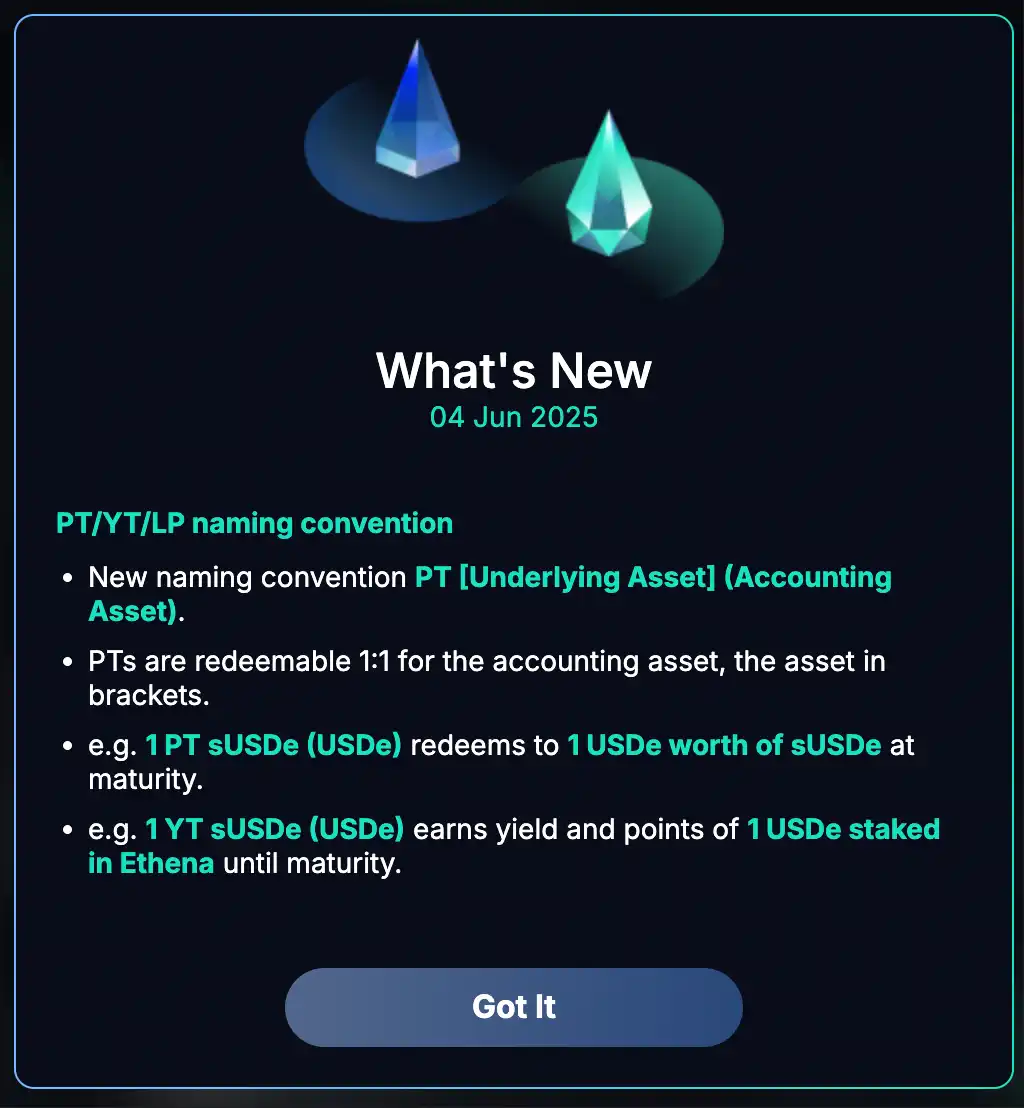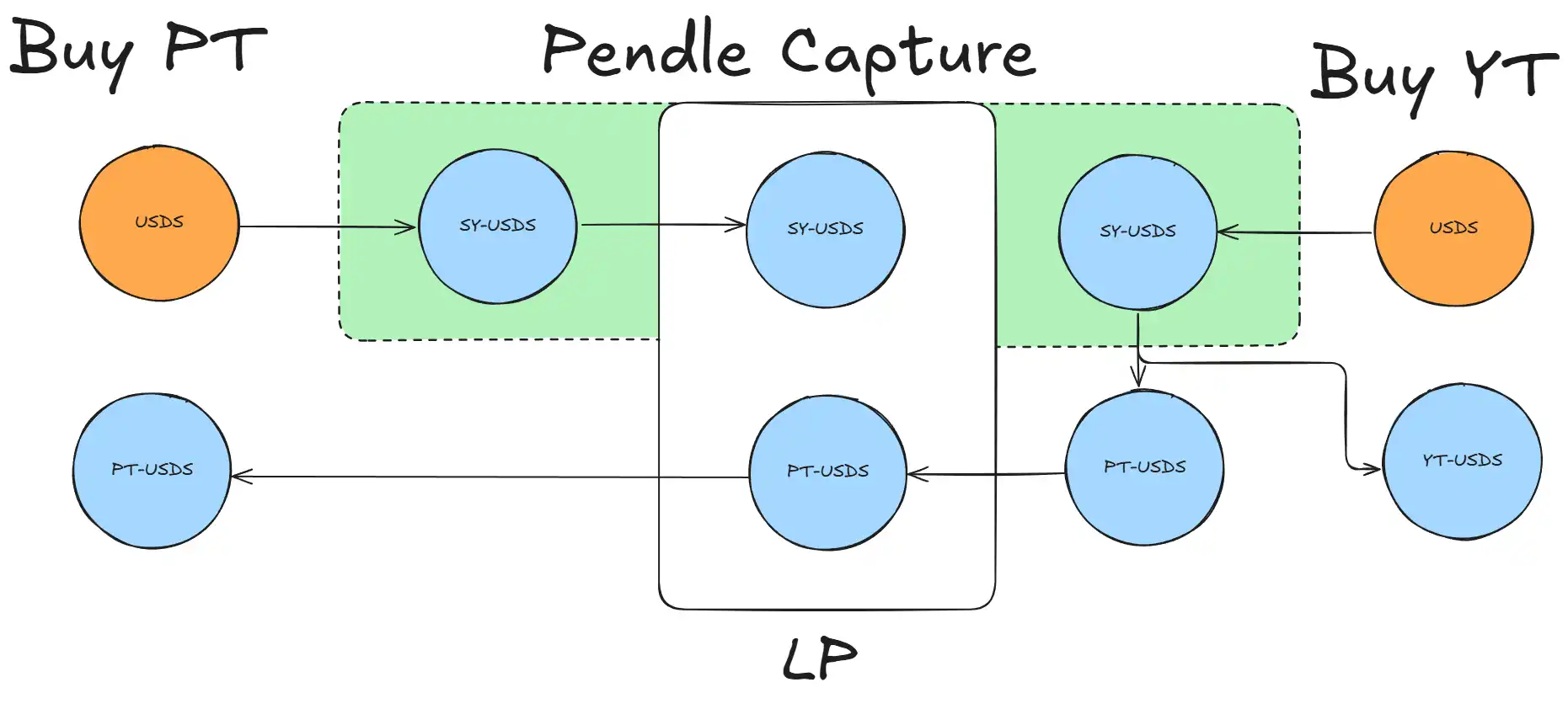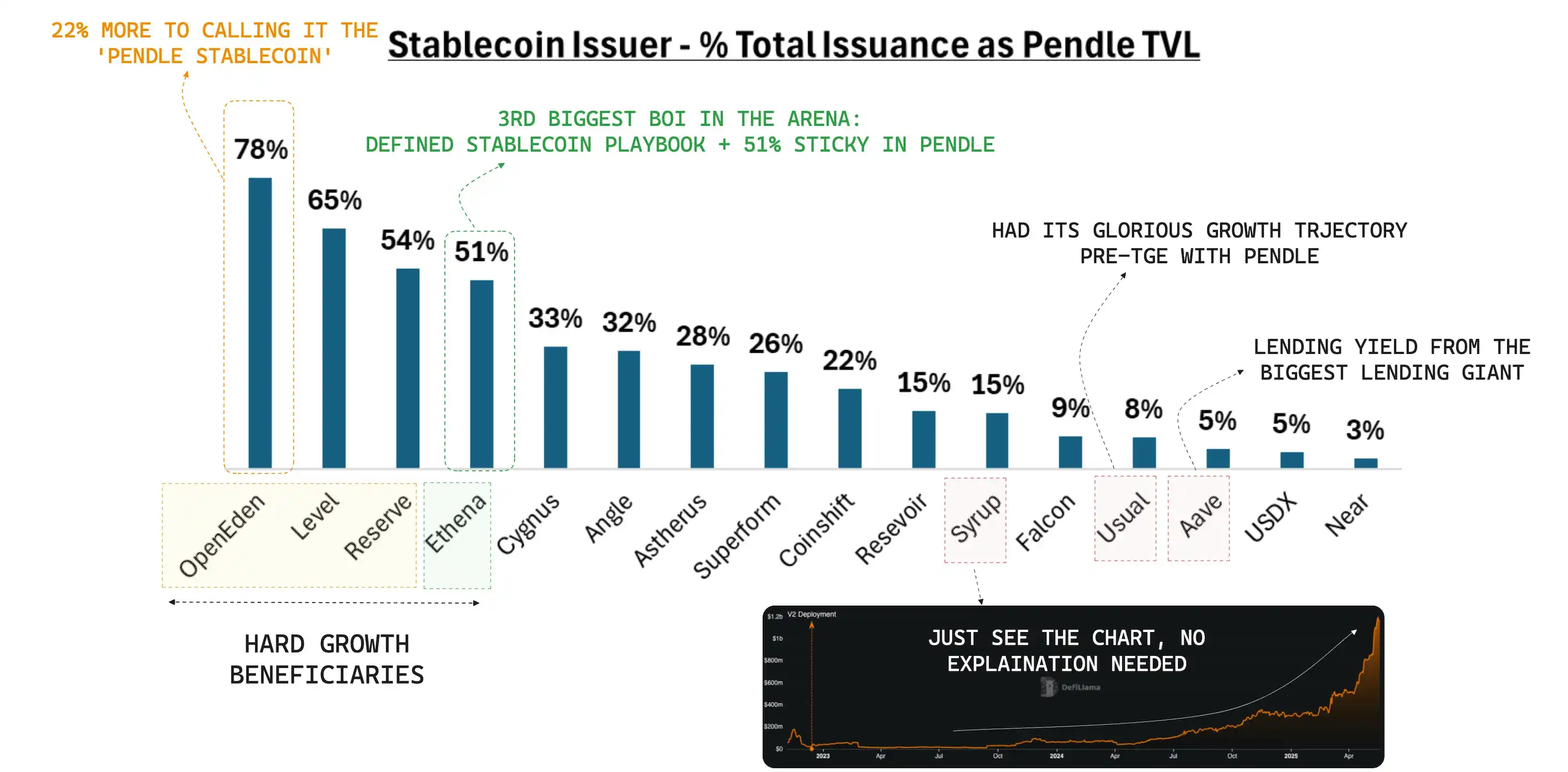In the past three to four years, the hot topics in the crypto world have switched like a carousel: the Ethereum merge ignited the LSD track, airdrop points pulled everyone into the "ranking frenzy," and now it's the turn of stablecoin yields to become the new focus. The excitement is the norm, but after each wave of noise recedes, Pendle can always be seen standing at the center stage—quietly yet steadily responsible for widening and deepening the underlying pipelines.
If the LSD heat of 2023 mainly relied on Lido for liquidity and Rocket Pool for decentralization, then the only one supporting yield splitting and pricing is Pendle; if in 2024 those playing airdrops rely on Excel to track points and Twitter to compare speeds, then it is still Pendle that directly prices "future yields" using YT; by 2025, as the market cap of stablecoins continues to rise and yield-bearing dollars dominate the narrative, the largest secondary trading venue will still be Pendle. Three phases of the market, one underlying thread—whoever masters the "disassembly" method of on-chain interest rates will be able to secure a position in the next narrative.
From USDT to PT: Stablecoins + Fixed Income Dual Engines
Now, when discussing stablecoins in the industry, the names that come up are not just USDT and USDC, the "old money," but also new faces like USDe, cUSD0, and LevelUSD that bring yields. The data is straightforward: in the past month, Pendle's TVL has accelerated into the second gear: reaching a historical high of 8.2 billion on August 9, and further approaching 9 billion on August 13. More critically, the "capital inflow strength"—Aave quietly raised the position limit of PT-USDe (Sep 2025) by another 600 million this week, and it was filled in less than an hour, showing that institutional and whale demand for PT has not only not been diverted but has actually strengthened.
Many people still remember Pendle as a "airdrop points paradise," but it has long since changed tracks. The naming of PT/YT has been changed to a more understandable format since June this year, clearly stating "1 PT matures to redeem principal, 1 YT accumulates all yields," so newcomers can understand without needing to consult Telegram groups. The backend has also added daily prompts, showing how much the position has moved and how much yield has been realized, with pop-ups informing you upon opening the webpage.

On the Tradfi side, the collaboration between Citadels and Edge Capital. This four hundred million dollar hedge fund has packaged its mEDGE strategy library into PT and directly thrown it into Pendle, with mEDGE's TVL already exceeding ten million dollars; on the other side, Spark's stablecoin USDS saw over a hundred million inflow in 24 hours, and just Spark's 25x points attracted a lot of yield farmers, pushing USDS TVL on Pendle to over two hundred million. The accompanying lending market is equally strong, with the total circulating PT in Aave surpassing several billion dollars—fixed income has truly begun to "turn into money."
Why PT is More "Resistant to Market Fluctuations": Taking Liquid Leverage Activities as an Example
On July 29, Ethena launched Liquid Leverage on Aave: users collateralized 50% USDe + 50% sUSDe, combining borrowing rates and promotional rewards, creating a more "market-oriented" yield route. On the day of launch, the market indeed discussed "Will it squeeze PT?" The reality was: the limit for Aave's PT-USDe was immediately snapped up, while part of the yield structure of Liquid Leverage comes from ENA ecosystem rewards, making it more sensitive to market conditions and activity intensity; conversely, PT's returns are locked in at a discount, resulting in smaller exposure to volatility. In other words: LL is like "sports drinks," while PT is more like "plain water + fixed deposit"—the former is strong during activity periods, while the latter is more stable after the activity subsides.
Citadels: Turning DeFi Fixed Income into an Empire
Simply put, Citadels is Pendle's "go out" plan: one hand pulls in traditional capital, while the other ventures into new public chains. Compliance, KYC, RWA, Solana, TON… it may sound complicated, but the core logic is simple: to take the PT/YT arbitrage rate puzzle to more environments, allowing any yield-generating asset to find a price on Pendle. If Pendle in the past was like a side quest-filled dungeon, then Citadels aims to build the main city into a financial empire, where anyone wanting to issue stablecoins, engage in RWA, or hedge funding rates must first come here to register.

Institutional PT and Cross-Chain PT: What’s the Next Step
Pendle's Citadels is not just a "renamed official page," but three real distribution channels:
(1) Non-EVM PT going abroad: bringing PT to high-speed ecosystems like Solana / TON / HYPE with one click, expanding the reachable user and asset pool;
(2) KYC compliant PT: targeting institutional wallets and brokerage interfaces, packaging on-chain fixed income into "compliantly held" assets;
(3) Direct connection with strategy providers: for example, Edge Capital's mEDGE has directly minted strategies into PT for distribution on Pendle, providing a bridge between "institutional strategies × DeFi fixed income." In simple terms: one PT, two legs to walk (cross-chain & institutional), placing the "interest rate puzzle" in front of more markets.
Why Pencosystem?
Pencosystem: What Happens After Disassembling Interest Rates
For protocol parties, Pendle has never been just a tool for "turning yields into tokens," but an engine that can amplify TVL, liquidity, and market signals simultaneously. Once the pool is set up, unilateral market making + zero IL directly retains LPs; the discount on PT and the premium on YT equate to a 24-hour price discovery dashboard, allowing the team to read the temperature of external funds in real-time. EtherFi is the most typical case—within less than half a year of launching Pendle on eETH, the protocol's TVL skyrocketed 15 times; LevelUSD's supply doubled in two months; the previously stagnant OpenEden also saw a 45% growth rate one month after launching the pool. In short: when Pendle wins, the underlying protocol wins along with it.

The magic of Pendle is not complicated: it splits an income-generating asset into fixed income and floating income halves. PT is like a one-year dollar bond, lying there to steadily earn 3-12% APY; YT is like an interest rate swap plus options, betting on airdrops, the Federal Reserve, and funding rates, all relying on it. After the split, the market flattens the price difference itself— the deeper the discount on PT, the more attractive the locked-in yield; the higher the premium on YT, the more people believe there will be future windfalls.
Don’t underestimate this kind of splitting; it allows LPs to earn fees by only betting on one side, with impermanent loss almost negligible, and they can use the split PT to cycle leverage on Aave. Large holders often use three to five times leverage to boost stable APY to 25-30%, all publicly recorded on the on-chain ledger, so real that even investment bank analysts can replicate the Excel template.
From the end of 2023 to now, Pendle has experienced 27 large maturity events, with 7 of them exceeding a billion in single maturity scale. The largest redemption last June was 3.8 billion dollars, and it was "cleared in seconds" on-chain; recently, on May 29, another 1.6 billion matured, with peak TVL dropping from 4.79 billion to 4.23 billion, and within a week it bounced back to 4.45 billion, maintaining a retention rate of 93%. Money doesn’t just come back out of thin air—35% of the matured funds rolled directly into new Pendle pools, marking the best seven-day retention record in history.
The Launchpad for Stablecoins
Stablecoins are the most direct and rewarding protagonists in Pendle's story. PT writes a fixed annualized return of 3-12% into on-chain contracts, while YT packages the "suspense" of future interest rates, airdrop points, and funding rates for speculators all at once—the result is that new dollars come with two product lines: stable coupon + high volatility bets.
The data is the most convincing: before reaching 1 billion TVL, half of USDe was locked in Pendle, and even as it approached nearly 6 billion, it maintained a 40% share; cUSD0 stagnated for three weeks, but after going on Pendle, it saw a 45% growth rate in a month; the latest USDS attracted 100 million dollars in just 24 hours. The liquidity retention is equally impressive: during the wave of 1.6 billion dollars maturing on May 29, the USDe-related TVL only dropped by 6%, and four days later, it was replenished. For any stablecoin, nothing is more appealing to institutional wallets than "funds returning along the same path after the peak."

In the past year, any yield-bearing stablecoin wanting to increase TVL would include "Pendle Pool" in the launch chapter of their white paper. LevelUSD doubled its supply in two and a half months, with Pendle pools' liquidity rising alongside it; OpenEden's cUSD0, which had previously stagnated, saw a straight 45% increase in less than a month after going on Pendle. Anyone wanting to issue new dollars has now defaulted to the script of first handing over price discovery and early liquidity to Pendle.
If we zoom out a bit further, stablecoins themselves are also undergoing a structural expansion trend. According to statistics from Modular Capital in their article "Pendle: Era of Stablecoin Expansion," the global supply of stablecoins has surpassed $250 billion, while yield-bearing stablecoins have risen from less than $1.5 billion to $11 billion in just eighteen months, increasing their share from 1% to 4.5%. The same report also conducted scenario assessments: under the backdrop of the implementation of the "GENIUS Act" and the Federal Reserve maintaining relatively high interest rates, the scale of stablecoins is expected to double again in the next 18–24 months to $500 billion; of which, 15% or $75 billion will flow into yield-bearing products.
If Pendle can maintain its current market share of about 30% as a "stable share," it means its TVL has the opportunity to rise to $20 billion, translating to an annual income of $200 million based on a 100bp fee rate—just as Modular Capital concluded: in the DeFi fixed income track, Pendle is likely to enjoy a dual valuation anchor of "U.S. Treasuries + Nasdaq growth stocks."
PT is Growing into an Economic Belt
Today, over 80% of Pendle's TVL consists of dollar assets, which can thrive in both bull and bear markets. The fixed APY has dropped from the once-boisterous 80-120% to now 3-12%, which may not sound as thrilling, but resembles a mature bond market. The circulation of PT in the three major money markets—Aave, Morpho, and Euler—has doubled in six months, surpassing $2 billion. Meanwhile, more and more LPs are rolling their maturing LPs directly into the next period, resulting in new TVL being "poured" in even faster.
Looking back at the market changes after July 29, PT's annualized returns have significantly outperformed collateral combinations that rely solely on borrowing to squeeze interest spreads during most periods, for two reasons: first, PT's "coupon" is locked in by its discount, unaffected by the direct impact of borrowing-side liquidity and promotional intensity; second, PT can be used as collateral in money markets like Aave for cyclical borrowing, forming a "fixed coupon × leverage" composite yield, with capital efficiency not inferior to traditional collateral. Aave's community risk control report also shows that the supply of PT as collateral has surged to several billion dollars within a month, indicating strong demand resilience.
The Era of Interest Rates Has Just Begun
Airdrop points can cause a brief market surge, but what truly attracts large funds is always "certain yields, ample liquidity, and comprehensive derivatives." Traditional finance has a coverage of $600 trillion in interest rate derivatives, while DeFi still lags far behind, not to mention that the actual yields traded within the industry are less than three percent. What Pendle has been doing over the past three years is slowly filling in that 97% gap.
Pendle's rise proves two things: on-chain, it is entirely possible to safely settle hundreds of millions in principal at maturity, and it can maintain capital stickiness even when the market cools; more importantly, it has pushed the value chain of interest rates from "project parties setting prices behind closed doors" to open bidding on-chain, with the market determining winners and losers. Moving forward, as long as there are yields, there will be people creating PT/YT; as long as there are people disassembling yields, it will be hard to leave Pendle. The airdrop season and altcoin season may pass, but the interest rate market has just opened; buckle up, the movie is only halfway through.
免责声明:本文章仅代表作者个人观点,不代表本平台的立场和观点。本文章仅供信息分享,不构成对任何人的任何投资建议。用户与作者之间的任何争议,与本平台无关。如网页中刊载的文章或图片涉及侵权,请提供相关的权利证明和身份证明发送邮件到support@aicoin.com,本平台相关工作人员将会进行核查。




